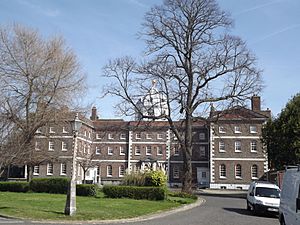Royal Naval Academy facts for kids
Quick facts for kids Royal Naval Academy |
|
|---|---|

Royal Naval Academy, Portsmouth
|
|
| Active | 1733–1837 |
| Country | |
| Branch | |
| Type | Training |
| Role | Officer training |
The Royal Naval Academy was a special school. It opened in 1733 in Portsmouth Dockyard. Its main goal was to train future officers for the Royal Navy.
The people who started the Academy wanted to offer a new way to become a naval officer. They aimed to provide standard training and education. In 1806, the school changed its name to the Royal Naval College. Later, in 1816, it became the Royal Naval College and the School for Naval Architecture. The Academy closed its doors for new officer training in 1837.
Contents
What Was Training Like?
In 1733, the Academy started in Portsmouth with 40 students. They learned many things, both in classrooms and at the dockyard. Students also gained practical experience at sea.
Graduates of the Academy could count two years of their studies as sea time. This meant they could take the lieutenant's exam sooner. They could take it after four years at sea instead of the usual six.
However, the Academy was not the most popular way to become an officer. Most officers still preferred the old way. This involved learning on a ship as an "apprentice." Many officers got their positions through family connections. They believed that real experience at sea was the best training.
King William IV once said that "there was no place superior to the quarterdeck of a British man of war for the education of a gentleman." This shows how much people valued learning directly on a ship.
Students from the Academy were sometimes called "midshipman-by-order." This was to show they were different from those who learned only at sea. After two years at sea, Academy graduates could become full midshipmen.
In 1806, the Academy became the "Royal Navy College." In 1816, it joined with the "School of Naval Architecture." The college stopped training young officers on March 30, 1837. After this, all young people starting a naval career went straight to sea.
The closure left a gap in officer training. So, in 1857, a ship called Illustrious became a training ship for cadets. In 1859, the Illustrious was replaced by Britannia. The Britannia later moved to Portland in 1862 and then to Dartmouth in 1863.
Famous People Who Attended
Many important people studied at the Royal Naval Academy.
- Philip Broke attended in 1791. He became famous as the captain of HMS Shannon. His ship won a big battle against USS Chesapeake during the War of 1812.
- Two of Jane Austen's brothers, Francis and Charles, also went to the Academy. Francis attended in 1786 and Charles in 1791. Both of them later became admirals.
- Henry Ducie Chads was another War of 1812 veteran. He studied at the Academy before joining the Royal Navy. He was the First Lieutenant of HMS Java. During a battle with USS Constitution, his captain was badly hurt. Chads took command but had to surrender the damaged Java.
Leaders of the Academy
The Academy had different leaders over the years.
Governors
- Captain Richard Hughes: 1733–1754
- Captain James Gambier: 1773–1778
- Captain Henry Martin: 1780–1790
Lieutenant-Governors
- Captain John Giffard: 1807–1819
- Captain John Wainwright: 1819
- Captain John Wentworth Loring: 1819–1837
Masters of the Academy
These individuals were in charge of teaching and the academic side of the Academy.
- Thomas Haselden, FRS: 1733–1740
- John Walton: 1740–1755
- John Robertson, FRS: 1755–1766
- George Witchell, FRS: 1766–1785
- William Bayly: 1785–1807
- James Inman: 1807–1838 (as Professor of the Royal Naval College)

